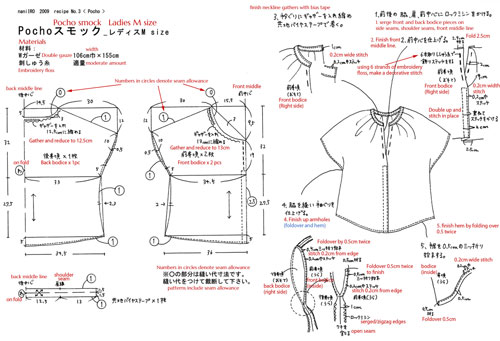Translated project #1 – Pocho Smock
I was asked to translated this pattern for a smock (nani IRO 2009 recipe No. 3) sometime end of last year. Finally got around to making one for myself! Before I sew with very precious fabric, I usually make a muslin first just to be sure the size and cutting is right. I made this out of clearance $3/m cotton lawn which was light and airy and perfect for this pattern. So I decide to finish it up properly and actually wear it!
There is supposed to be some embroidered detail down the front opening, but I’ve decided to leave that out. Here’s a close up of the finishing around the collar.
And the sleeves. It’s a loose fitting smock so it’s quite forgiving when it comes to the fit. Love it!
Click image to view.
Project number 2 that was translated is the Apron dress.
This was requested by Jaya recently and unfortunately that is the largest size of the finished picture I could find. It’s basically an apron layered dress. Size 110. This pattern is from the 2006 collection of patterns.
The original pattern link is here
http://naniiro.jp/textile/pattern-making/pm2006









10 Comments
Soon I will learn how to sew so that I can make lovely things like that. But it seems so complicated, even with the translation. Still, thank you for the translation. Hopefully, one day, I will understand what all that means 🙂
thanks so much!
i will post a picture of the project very soon 🙂
Thank you so much for your translations! I am hoping I will get a chance to sew this up soon!
I made it! you can see it here
I would love help with translation! I bought this book…Handmade Baby Clothes – Japanese Sewing Pattern Book for Lovely Babies – Yoshiko Tsukiori – B283. Author: Yoshiko Tsukiori
Publisher: Bunka Shuppan Kyoku
Date of Publication: 2006/05
Have you translated it? I purchased it from Japan Lovely Crafts on Etsy. It is such a sweet book. If you haven’t translated it, do you think you could translate a project from it for me?…or do you do whole books? Let me know. Do you have a list of things you have translated? Thank you so much!
Hi Rebecca, I can help you translate a project if you need. I am not a professional translator, so I’m not actually translating whole books. 🙂 you can send me clear photos of the project you need help with and I’ll see what I can do.
Where is the pattern for nani IRO pocho smock?? it has been more than year…I would love to make a smock for myself!! Thank you!
Hi Karin,
The link to the Japanese pattern is in the blog post, and for the translated instructions just click on the image to see it in a larger image.
Delighted to have found the Nani Iro 2013 recipe No.5 woman T shirt. I’m happy with all the measurements but I’m stuck with the instructions for the neck line? Are you able to explain it to me? THANK YOU VERY MUCH INDEED!
Hi Rebecca,
You are supposed to make, using the same fabric, a bias tape 76cm long, 4cm wide, folded 1cm inwards on both long edges to make a bias tape that is 2cm wide.
Then, in step 4 of the instructions, place the right side of the bias tape facing the right side of the t-shirt neckline, sew 1cm from edge of neckline.
Turn the bias towards the wrong side of the t-shirt, so that the entire bias tape (2cm width) is inside the t-shirt. Sew 0.25cm from the outer edge of the bias tape.
From the outside of the t-shirt you won’t be able to see the bias tape. Here’s an example of what it should look like https://www.youtube.com/watch?v=tpaaY9rth8c
Hope this helps!